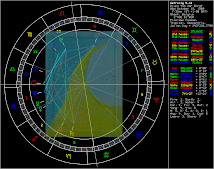Revisiting Structuralism: its mediated existence
Struc·tur·al·ism
1.) A method of interpretation and analysis of aspects of human cognition, behavior, culture, and experience that focuses on relationships of contrast between elements in a conceptual system that reflect patterns underlying a superficial diversity
2.) The doctrine that structure is more important than function
Web definitions
__ linguistics defined as the analysis of formal structures in a text or discourse
__an anthropological theory that there are unobservable social structures that generate observable social phenomena
__ a sociological theory based on the premise that society comes before individuals
wordnetweb.princeton.edu/perl/webwn
---------------------------------------------------------------
The Zodiac of Astrology simply reflects the idea of unobserved structure as it occurs in language, art, and philosophy; it did not invent hidden or "occult" structures.
___Though while young I may have been somewhat unaware of my own preferences for a more structured life, it is true that a more predictable or understandable one has come to be much more desirable than a more rebellion-inclined, happy-go-lucky, chaotic one. And, I kind of like my ideas to be more like me in that respect. I would rather brood a little on a regular basis and feel a little boxed in than to feel always left adrift and or all at sea. The reality we should then hope for, the one I actually want to live in, should be one of strong but adaptable forms, persistent but amenable, like the structure of language itself. So eventually it did come to my mind, as if in the case of a truth by way unwilling belief, that the above mentioned idea--that there indeed are "unobservable" structures tending to dictate how one thing, concept, or idea ,relates to another, actually does play an important part in my personal philosophy, my world view. Due to having no particular interest in extreme positions or absolutist's dogma, I see the pragmatic incorporation of structuralism and its mediation--the de-structuralising oppositional forces of intervening individualistic chaos--the presence of mold-breaking inventiveness in the world, as being both beneficial and essential to my imagining the state of reality the best I can. Faith, in this respect, is an unyielding belief that I too am entitled to a somewhat agreeably formed and dependable vision of a workable 'reality'.
What does the most general form of this structuring-of-everything look like? Say, if it were condensed to a circular graph composed of all the potentials for a harmonized plurality of life's expressions ?
__This is were all the fun begins. Having searched life experiences for a suitable circular graphing idea candidate, it is hard to miss that astrologers may have already attempted this organizational chart in the forming of the Zodiac concept. Though it is probably part revelation or inspiration, what if it is also 98% perspiration as well. What if the ancients were at least as intelligent as moderns? Could they have been at least as seriously working at philosophy and psychology, not merely dogmatic theology, with the same highest of intentions that most of us would so willing ascribe to the academic scholars of our own day? In contemplating the apparent relationships between major concepts of Western culture; how we are logocentric, meaning a word stands for a thing's existence, and how we tend to value reason with an appeal to a logic with its categorical forms, how we state what is included or excluded from a given word or statement. I here began with the plotting position of "Up" as being most authoritative and purpose-driven place of any such attempt at graphing our collective thinking habits or nature upon a circle:

__It wasn't too long after constructing this graphic, I began reading about the topic of Linguistics, and so encountered the works of one Steven Pinker. Lo and behold, he had already created a similar graph:
__It wasn't too long after constructing this graphic, I began reading about the topic of Linguistics, and so encountered the works of one Steven Pinker. Lo and behold, he had already created a similar graph:







